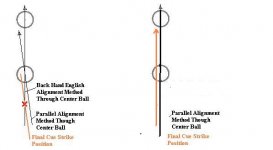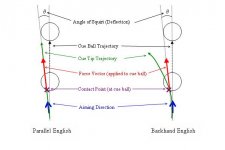Colin Colenso said:Hi jsp,
I think Backhand English should really be called something like Backhand Alignment for English. It is really an alignment methodolgy, not a type of English.
Some players use this method cueing straight through english and others with the swoop.
It may make more sense to say swoop english is a different type of english.
The common denominator between Aim and Pivot BHE or Aim and Swoop BHE is that the bridge hand is in the same place.....They are both simply BHE
BHE: your bridge hand is set up for a "center hit"
Paralell English: your bridge hand is set up for a "off center hit"
The bridge hand being set up for a center CB hit is what makes the deflection compensation so much easier to judge...
BHE almost eliminates any need for squirt or deflection compensation (whichever anyone calls it)...and since the angle of attack from the shaft is different from PE to BHE, you get more spin from BHE even though your tip is hitting the exact same spot as you would for PE...With BHE you are able to move the tip closer to center and still achieve the desired spin on the CB
Last edited:

